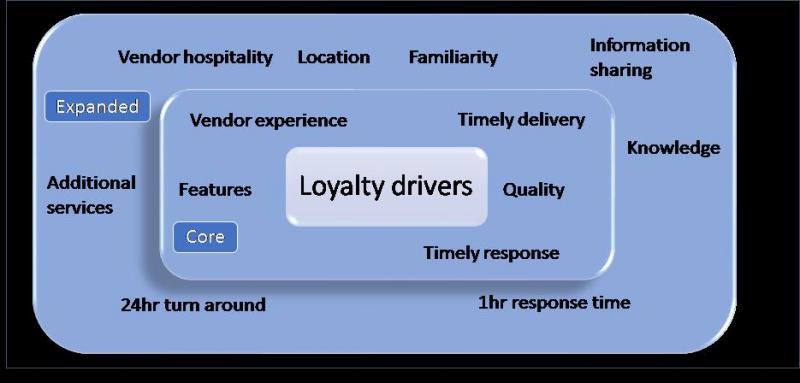7 Steps to Improve Customer Loyalty Through B2B Marketing

Customer loyalty can be understood as the gravitational pull a company has on a customer, or the bond or attachment a customer has for a company or brand. Customer loyalty can be shaped by many things including sales engagement, salespeople, customer services, operations and both direct and indirect marketing.
When we think of elements that impact our loyalty, much of it comes down to marketing, meaning B2B marketers can do a great deal to shape and improve customer loyalty for their organization.
Traditionally, once a customer has made their purchase, the responsibility of retaining that customer falls to the sales, operations and procurement teams – but times have changed. Nowadays when we look at customer loyalty, there are many more opportunities for vendors to influence customers’ future buying and purchase behaviour through digital channels and content marketing. As a result, marketing’s role in steering customers’ loyalty has grown immensely.
Here is the seven-step process for improving customer stickiness within your organization:
Step 1: Define who your customer is and what they value
The first step a vendor should take to achieve loyalty is to understand exactly what a customer values, largely by considering the diversity in customers and the variety of stakeholders in the buying journey. Defining the segment and stakeholders is key to determining what aspects they value most.
Step 2: Rank and prioritize loyalty drivers
The next step is to rank and prioritize loyalty drivers. Is price the key thing, or is it a timely response or quality of information? Is it being up to date with market trends or research reports?
In this respect, the vendor needs to split out the core and expected elements in their offering and combine them with those aspects that drive loyalty. For example, a timely response is probably expected, but the speed of response - such as 1 hour or a 24-hour turnaround - may not be.
Marketers can use this qualitative research to rank the information into ‘Core’ or ‘Expanded’ loyalty drivers, where ‘Core’ reflects the main loyalty driver and ‘Expanded’ a supporting element in driving customer loyalty (see the below diagram).

Step 3: Align your communications approach
When considering ‘how’ to communicate to your customers, marketers should look at 3 core areas: themes that customers prefer to hear about, channels they prefer to receive the information on, and the frequency they wish to be communicated to. Some customers may prefer not to receive email at all whereas others may prefer to receive updates via an online information page, social media or direct mail.
Here it is important to offer alternative forms of communication for your customers. As well as diversifying the types of channel used, vendors can set up communication preference systems. Once implemented, these media consumption habits should be tracked and reviewed through digital and analytical methods.
Step 4: Track customer engagement and sentiment
Before digital, one area vendors found difficult to track was customer sentiment. Previously, companies would rely on account managers or ad-hoc conversations to understand the mood and sentiment of their customers, yet now, sentiment can be captured in a much more structured way, be it via digital surveys or social monitoring and listening to track keywords.
As well as tracking sentiment, companies can look at the context of the sentiment and create responses to address it. Providing customers with an outlet to voice their opinions can be powerful, as the customer feels listened to. This can be more than just a monitored customer services Twitter handle and may include surveys, events, roundtables, or even dedicated customer council meetings selecting topics chosen by the customer.
Step 5: Inclusion
Using social media to support customer loyalty can be powerful. One way is to use it to create a community (or to take part in an existing one) and involve customers in key processes such as product or service development. A great example of this is Dell’s Ideastorm online platform, which collects ideas from customers and has new ideas ratified by them. It prioritizes the customer suggestions they decide to implement and ensures it is visible and transparent on the Ideastorm site.
Step 6: Understand current and future customer needs
Clues to customers needs and interests can lie in their website behaviour; organizations now have the ability to monitor customers browsing habits beyond their own website. Typically this would be through a third party organization or software, but there are other options. One may be designing your website to tag existing customers by the phrases they search and pages they view, offering clues to their future interests or purchases.
Step 7: Set up appropriate customer response systems
It is not enough for organizations to monitor and capture customer information: they must have a response mechanism in place for if a customer highlights a problem and requires an urgent response. Because of this, the role of marketing is two-fold:
- To understand overall customer concerns, feedback, questions and sentiment
- To build an appropriate marketing plan, strategy and mix to cater to these insights
An example of this might be where a customer has misinterpreted the company’s offering or portfolio, thus requiring an integrated message to respond to this perception. Another example would be customers commenting on the timing of information or whether they receive too much or too little. In this respect, marketing can support the sales team by providing relevant and timely information intended for the customer.
This final step ties into understanding what the customer values. It is crucial that businesses use response systems to gather insights and support this service, in order to improve customer loyalty.




